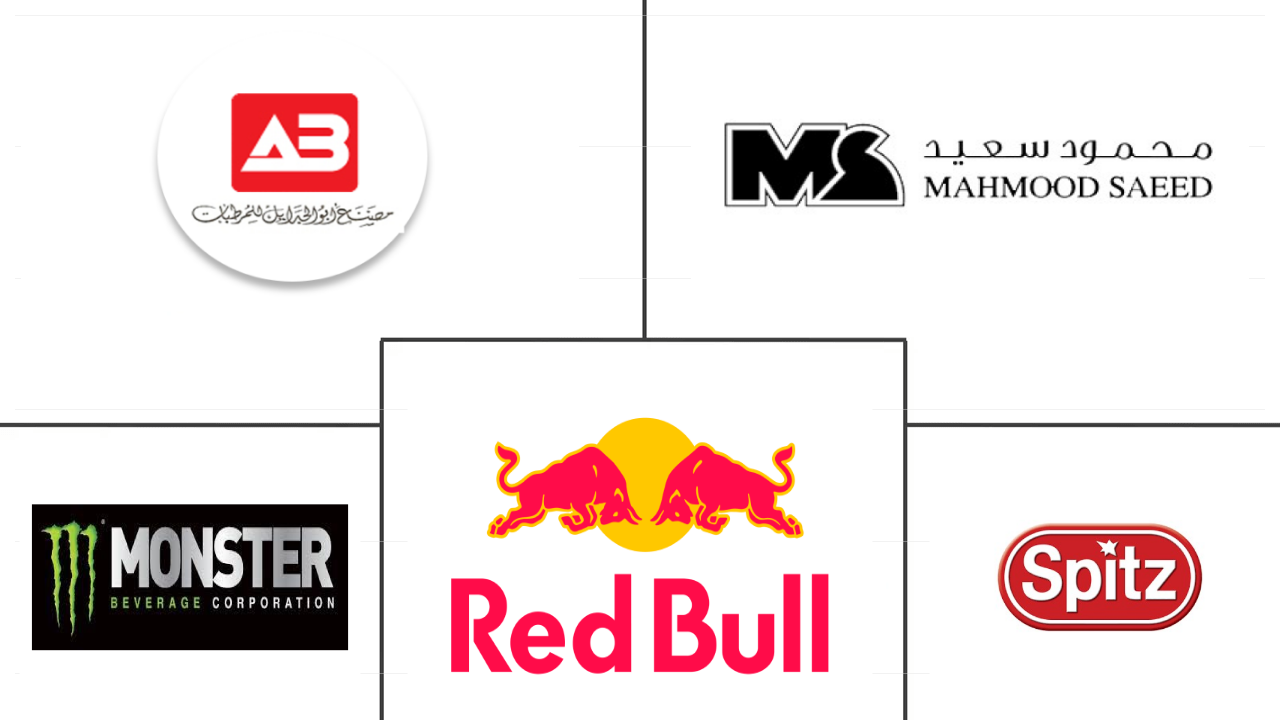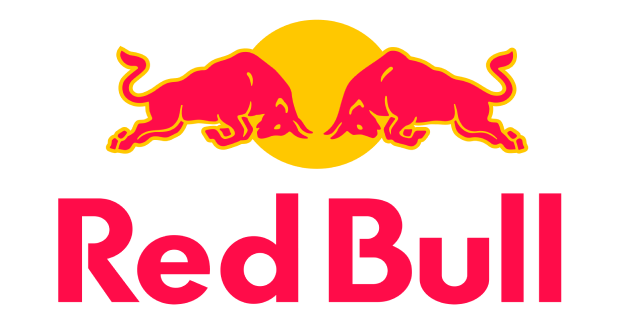Market Size of middle east energy drinks Industry
| Icons | Lable | Value |
|---|---|---|
|
|
Study Period | 2018 - 2030 |
|
|
Market Size (2024) | USD 2.37 Billion |
|
|
Market Size (2030) | USD 3.19 Billion |
|
|
Largest Share by Soft Drink Type | Traditional Energy Drinks |
|
|
CAGR (2024 - 2030) | 5.12 % |
|
|
Largest Share by Country | Saudi Arabia |
|
|
Market Concentration | Low |
Major Players |
||

|
||
|
*Disclaimer: Major Players sorted in no particular order |
Middle East Energy Drinks Market Analysis
The Middle East Energy Drinks Market size is estimated at 2.37 billion USD in 2024, and is expected to reach 3.19 billion USD by 2030, growing at a CAGR of 5.12% during the forecast period (2024-2030).
2.37 Billion
Market Size in 2024 (USD)
3.19 Billion
Market Size in 2030 (USD)
4.19 %
CAGR (2018-2023)
5.12 %
CAGR (2024-2030)
Largest Segment by Soft Drink Type
46.06 %
value share, Traditional Energy Drinks, 2023
The rising consumer engagement in extensive workouts and fitness programms in response to the obesity prevalence is driving the demand for traditional energy drinks
Fastest-growing segment by Soft Drink Type
6.68 %
Projected CAGR, Natural/Organic Energy Drinks, 2024-2030
The consumer willingness to pay premium prices for high quality products accompanied with health and wellness trend promotes opportunities for natural/organic energy drinks
Leading Market Player
13.98 %
market share, Red Bull GmbH, 2022

Red Bull GmbH maintains its leading position in the market through strong focus on product innovation and widespread distribution capabilities to target larger consumer base
Largest Segment by Country
55.22 %
value share, Saudi Arabia, 2023
Strict prohibition of alcohol consumption has increased the appeal of energy drinks as a social drink among young consumers which in turn drives the segment growth
Fastest-growing segment by Country
5.58 %
Projected CAGR, Saudi Arabia, 2024-2030
Ongoing investments in sports training academies and expected international sports tournaments shortly are estimated to drive energy drink sales in Saudi Arabia
Sugar-free and natural energy drinks are gaining popularity in the Middle East
- The Middle East witnessed a significant surge in the popularity of energy drinks in recent years. Several factors, including a burgeoning youthful demographic, rapid urbanization, and fast-paced lifestyle changes, drive this increase in demand. As health consciousness rises among consumers, global giants like Red Bull and Monster, alongside regional brands, have successfully penetrated the market. Notably, sugar-free flavored variants are gaining considerable traction. The sales value of energy drinks in the region experienced a robust growth of 19.09% from 2018 to 2023.
- In 2023, traditional energy drinks maintained their dominance in the market. The widespread availability and easy accessibility of energy drinks in a variety of novel flavors and ingredient combinations boost their continued growth. These beverages are available as standalone products and in innovative combinations with juices or spirits, such as mocktails and cocktails. The 18 to 29 age group represents a significant 70% of energy drink consumption, with Saudis alone spending up to USD 1.5 billion annually on these beverages.
- Within the energy drinks category, the Middle East is experiencing a rapid increase in demand for natural and organic variants. With a projected CAGR of 6.18% from 2024 to 2030, these drinks are the fastest-growing type in the energy drinks segment. Consumers, particularly in Saudi Arabia, are increasingly opting for clean-label options, specifically emphasizing sugar-free, nutrient-rich, gluten-free, and organic products. This shift is driven by a heightened awareness of the potential hazards associated with conventional beverage production and a growing appreciation for the benefits that organic drinks offer.
Major sports events and touristic activities in the region are boosting energy drink sales in the market
- The Middle East has witnessed a consistent uptick in the demand for energy drinks in recent years. In 2023, the region experienced a notable 8.40% growth in value compared to 2021. This surge can be attributed to the region's burgeoning sports culture, highlighted by the hosting of major events like the 2022 Qatar FIFA World Cup, Abu Dhabi Grand Prix, Dubai Marathon, and UFC. This, coupled with a rising trend of sports tourism, has fueled the market's expansion. The growing emphasis on health and fitness has led to energy drinks becoming a staple for individuals engaged in sports and fitness activities.
- Saudi Arabia is poised to be the frontrunner, with a projected volume CAGR of 5.38% from 2024 to 2030. Energy drinks hold particular appeal for the country's urban, younger population, especially students, seeking a quick energy boost. Furthermore, the increasing engagement of Saudi consumers in both physical and e-sports is a significant market driver. In 2022, a striking 72% of e-sports gamers in Saudi Arabia fell within the 18-24 age bracket.
- Shifting cultural attitudes, particularly a growing acceptance of non-traditional beverages, have propelled the popularity of energy drinks in the Middle East. Notably, countries like the UAE, Saudi Arabia, and Qatar, renowned for their leisure activities, witness a substantial influx of tourists. This, in turn, amplifies the visibility of energy drink purchases, as visitors exploring these locales and attending events often seek a quick energy boost. For instance, Dubai welcomed a staggering 14.36 million international overnight visitors in 2022, marking a remarkable 97% Y-o-Y growth from the 7.28 million arrivals in 2021. Similarly, Saudi Arabia saw its tourist arrivals surge from 3.48 million in 2021 to 16.51 million in 2022.
Middle East Energy Drinks Industry Segmentation
Energy Shots, Natural/Organic Energy Drinks, Sugar-free or Low-calories Energy Drinks, Traditional Energy Drinks are covered as segments by Soft Drink Type. Glass Bottles, Metal Can, PET Bottles are covered as segments by Packaging Type. Off-trade, On-trade are covered as segments by Distribution Channel. Qatar, Saudi Arabia, United Arab Emirates are covered as segments by Country.
- The Middle East witnessed a significant surge in the popularity of energy drinks in recent years. Several factors, including a burgeoning youthful demographic, rapid urbanization, and fast-paced lifestyle changes, drive this increase in demand. As health consciousness rises among consumers, global giants like Red Bull and Monster, alongside regional brands, have successfully penetrated the market. Notably, sugar-free flavored variants are gaining considerable traction. The sales value of energy drinks in the region experienced a robust growth of 19.09% from 2018 to 2023.
- In 2023, traditional energy drinks maintained their dominance in the market. The widespread availability and easy accessibility of energy drinks in a variety of novel flavors and ingredient combinations boost their continued growth. These beverages are available as standalone products and in innovative combinations with juices or spirits, such as mocktails and cocktails. The 18 to 29 age group represents a significant 70% of energy drink consumption, with Saudis alone spending up to USD 1.5 billion annually on these beverages.
- Within the energy drinks category, the Middle East is experiencing a rapid increase in demand for natural and organic variants. With a projected CAGR of 6.18% from 2024 to 2030, these drinks are the fastest-growing type in the energy drinks segment. Consumers, particularly in Saudi Arabia, are increasingly opting for clean-label options, specifically emphasizing sugar-free, nutrient-rich, gluten-free, and organic products. This shift is driven by a heightened awareness of the potential hazards associated with conventional beverage production and a growing appreciation for the benefits that organic drinks offer.
| Soft Drink Type | |
| Energy Shots | |
| Natural/Organic Energy Drinks | |
| Sugar-free or Low-calories Energy Drinks | |
| Traditional Energy Drinks | |
| Other Energy Drinks |
| Packaging Type | |
| Glass Bottles | |
| Metal Can | |
| PET Bottles |
| Distribution Channel | ||||||
| ||||||
| On-trade |
| Country | |
| Qatar | |
| Saudi Arabia | |
| United Arab Emirates | |
| Rest of Middle East |
Middle East Energy Drinks Market Size Summary
The Middle East energy drinks market is experiencing a dynamic transformation, driven by a youthful demographic, rapid urbanization, and lifestyle changes. The market is characterized by the growing popularity of both traditional and innovative energy drink variants, including sugar-free and organic options. Global brands like Red Bull and Monster, alongside regional players, have successfully penetrated the market, catering to the increasing demand for health-conscious beverages. The region's sports culture and tourism, highlighted by major events and a rising trend in sports tourism, have further fueled market expansion. The consumption of energy drinks is particularly prevalent among the younger population, with a significant portion of consumers seeking quick energy boosts to support their active lifestyles.
The market landscape is fragmented, with key players such as Abuljadayel Beverages Industries, Mahmood Saeed Group, Monster Beverage Corporation, Red Bull GmbH, and S. Spitz GmbH holding a substantial share. The demand for organic and sugar-free energy drinks is on the rise, driven by health concerns and a growing awareness of the benefits of clean-label products. Price sensitivity among consumers, especially during economic downturns, influences purchasing decisions, with retailers offering competitive pricing and promotions. The introduction of new products, such as Monster Energy Zero Sugar and Red Bull's Apricot-Strawberry flavor, reflects the industry's response to evolving consumer preferences. As the market continues to grow, companies are investing in innovative offerings to capture the attention of health-conscious consumers in the region.
Middle East Energy Drinks Market Size - Table of Contents
-
1. MARKET SEGMENTATION (includes market size in Value in USD and Volume, Forecasts up to 2030 and analysis of growth prospects)
-
1.1 Soft Drink Type
-
1.1.1 Energy Shots
-
1.1.2 Natural/Organic Energy Drinks
-
1.1.3 Sugar-free or Low-calories Energy Drinks
-
1.1.4 Traditional Energy Drinks
-
1.1.5 Other Energy Drinks
-
-
1.2 Packaging Type
-
1.2.1 Glass Bottles
-
1.2.2 Metal Can
-
1.2.3 PET Bottles
-
-
1.3 Distribution Channel
-
1.3.1 Off-trade
-
1.3.1.1 Convenience Stores
-
1.3.1.2 Online Retail
-
1.3.1.3 Supermarket/Hypermarket
-
1.3.1.4 Others
-
-
1.3.2 On-trade
-
-
1.4 Country
-
1.4.1 Qatar
-
1.4.2 Saudi Arabia
-
1.4.3 United Arab Emirates
-
1.4.4 Rest of Middle East
-
-
Middle East Energy Drinks Market Size FAQs
How big is the Middle East Energy Drinks Market?
The Middle East Energy Drinks Market size is expected to reach USD 2.37 billion in 2024 and grow at a CAGR of 5.12% to reach USD 3.19 billion by 2030.
What is the current Middle East Energy Drinks Market size?
In 2024, the Middle East Energy Drinks Market size is expected to reach USD 2.37 billion.

